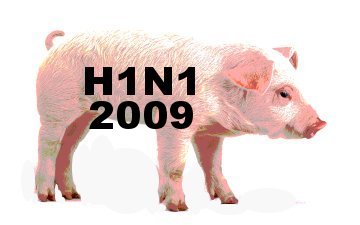Pregnancy, Swine Flu, Prevention & Treatment
Flu Effects During Pregnancy
In the Past
During the 1918~1919 Spanish Flu pandemic, men who were exposed to flu in the womb were twenty three (23%) percent more likely, than the rest of the population, to develop heart disease after the age of 60. These same men were slightly shorter then men born in the years before and after the pandemic.
This from University of Southern California (USC) Davis School of Gerontology research.
They also found that women exposed to the flu in the womb in the first trimester were seventeen (17%) percent more likely, than the rest of the female population, to develop heart disease after the age of 60.
This report can be found in the Journal of Developmental Origins of Health and Disease.
As dire as this sounds, these estimates may actually be conservative with likely more of both sexes suffering the consequences of flu during gestation and development. This is because it is thought that those most severely affected were likely to have died before the age of 60.
Though it's true that the Spanish flu virus was much more lethal than Swine Flu, the data indicate that mothers who survived the infection were likely to have suffered a milder case of flu. Now add this fact, pregnant women who contract Swine Flu are six times more likely to be hospitalized for complications and those complications could impair the fetal development.
Caleb Finch and his colleagues combed through the records of one hundred thousand (101,068) people born between 1915 and 1923. These are people who responded to the National Health Review Survey conducted between 1983 to 1996 by the National Center for Health Statistics.
From this pool, they calculated the increase in heart disease
for those exposed to the virus in the womb. Data also included information from the Army
enrollment health records for two million seven hundred thousand (2.7 million) men whose year of birth
was between 1915 and 1923. Findings indicated that there was a slight height increase in men every year during this range except for those born immediately after the epidemic. The average height decrease was 0.05 inches shorter than those during the previous year. Not significant, but calculable.
In general, previous studies by the USC Davis School of Gerontology have shown that inflammation and infections during pregnancy can affect development in the womb. This effect is long lasting, extending well into later life. These findings confirm the long lasting effects of influenza and give some urgency to the need for pregnant women to seek out inoculation.

Pregnancy and Swine Flu
Swine
flu, or H1N1, can be more dangerous for pregnant women. If you are pregnant or about to become pregnant you should be aware of the following:
- Because pregnancy taxes the immune system, pregnant women are much more vulnerable to flu infection. This includes the (2009 H1N1) Swine flu.
- Pregnant women are much more likely to have a severe case of flu than the general population.
- In late pregnancy, due to the baby pushing up against the diaphragm, a case of the flu developing into pneumonia could be much more serious.
- Pregnant women are hospitalized four times more often than the general population with Swine Flu.
-
Vaccines slated for release in early October will most likely be the nasal spray variety. This contains a live virus which means doctors will be reluctant to give this particular vaccine to pregnant women. This is true of the winter flu nasal vaccination as well.
Mid-October will see the release of an injection vaccine containing a dead virus. This will be much safer for pregnant women. This represents forty (40) million doses. Note: This time-line has slipped. The CDC is now saying the end of October and 28 to 30 million doses; not 40 million.
- Getting the vaccine is risky, but far less risky that not getting it at all. Research has shown that pregnant women are far less likely to use drugs or get the normal round of vaccines. Concerns about Swine Flu Vaccine fall into the same category of suspicious treatments mothers avoid. So far, injection site soreness and feeling flu like symptoms for one day seem to be the only side effects.
- As of this writing there appear to be no risks to the developing baby, though ongoing trials in pregnant women will make a clearer determination. It is known that there are far more risks to the baby if the mother contracts any flu; not just Swine Flu.
- Swine Flu vaccines do produce the proper antibodies in the mother. These are passed on, through the placenta to the baby, giving that child protection from flu before s/he can get his own vaccination at six months.
- A Thimerosal (mercury) free version is available. All the mother has to do is ask for it.
There have been news reports that more than thirteen (13%) percent of those who died from Swine Flu were pregnant women even though they make up less than one percent (1%) of the population.
These reports were based on a mere forty-five (45) cases. A far too small sample of the population for scientists to draw any conclusions.
Newer figures, from much more reliable surveys, indicate a rate of six (6%) percent which is still cause for concern.
Additional Precautions and Actions
Women who are pregnant or about to become pregnant during this pandemic should also:.
- Wash your hands often.
- Avoid contact with those around you who are sick.
- Avoid touching your nose, eyes, or mouth.
- Stay home if sick.
- Cover your nose and mouth should you sneeze or cough.
If you are pregnant and think you've contracted the flu you should:
- Contact a health care provider immediately. They may be able to prescribe an anti-viral.
- Talk to your health care provider before taking any "over the counter" flu medications; these may affect your baby.
- Talk to your health care provider before taking herbal or natural supplements; these may also affect your baby.
- Get lots of rest and drink plenty of (non-alcoholic) fluids.
Updates
October 7, 2009
The Swine Flu nasal vaccination is
now available in Indiana, Illinois and Tennessee. These states must
share the seven (7) million doses available. The injection form will be
available next week.
October 16, 2009
The CDC is now saying only 28 to 30 million (not 40 million as projected) doses of an injection vaccine will be available by the end of October. The original projection was mid-month October e.g. now.
October 21, 2009
The CDC now reports that Swine Flu (2009H1N1) injectable vaccine will not be widely available until mid-November.
Coda
I've seen signs, print ads, and television advertising for flu shots. Many say they are available now! Since mid-October is the announced date of availability I doubt it's for Swine Flu. It might just be for the regular winter flu.
Be sure to ask and make sure what you are getting.
Tamiflu Problems
Confusing directions
Doctors often prescribe Tamiflu in fractions of teaspoons; however, the dropper packaged with the drug is in milligrams.
This potential confusion in directions could cause parents to mistakenly give too little or too much of the drug to their children. Too little and the child's recovery will be impeded. Too much and parents could be facing a toxic overdose.
Dr. Michael Wolf of Northwestern University's Feinberg School of Medicine stated: "It's an egregious error that there is a conflict in the prescription labeling instructions and the dosage device that comes in the exact same box, It's incredibly confusing to parents."
This is a real problem. A teaspoon is a measure by volume. A milligram is a measure by weight. The two don't really convert from one to the other.
So, should your doctor prescribe Tamiflu be sure to ask him/her to prescribe the recommended amount in milligrams not teaspoons or fractions of teaspoons.
Children's Tylenol (Acetaminophen)
Medical researchers testing both the Swine and Winter flu vaccines have found that giving Children's Tylenoltm (or any child's Acetaminophen medication) can actually reduce the effectiveness of the vaccine. Why this happens is not yet known, but the effect is real.
Therefore health researchers are now recommending that Children's Tylenol (or children's Acetaminophen) not be given during the first days after vaccination. -- Source MSN Health & Fitness, Atlanta Journal Constitution
- What is Influenza
Nineteenth Viral Century History Influenza is a virus. A virus (Latin for poison) is not made of cells, but rather is made up of some of the components of cells. A virus can only reproduce (replicate) inside... - Pregnancy, Swine Flu, Prevention & Treatment
In the Past During the 1918~1919 Spanish Flu pandemic, men who were exposed to flu in the womb were twenty three (23%) percent more likely, than the rest of the population, to develop heart disease after the... - Swine Flu Vaccine Dosing
As of October 15, 2009 we are still a few weeks away from all states having an injectable vaccine. However, nasal (live virus) vaccines are now available in most states. This hub will discuss which version...








